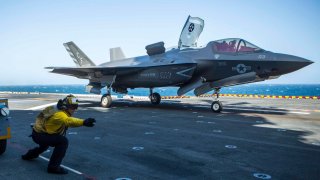How China Is Driving Japan to Buy More F-35 Stealth Fighters
The possibility of a huge Japanese F-35 jet buy introduces a wide sphere of tactical and strategic dynamics for the power-balance in the region.
Here's What You Need to Remember: The F-35 jet’s drone-like surveillance capability, which includes the technical capacity to detect enemy assets at long distances before it is seen itself, would certainly offer Japanese forces vastly improved defensive opportunities. A Japanese military armed with F-35 aircraft and less restricted might also function as an even more credible deterrent or counterbalance against Chinese provocations in the region.
The F-35 jet’s drone-like surveillance capability, which includes the technical capacity to detect enemy assets at long distances before it is seen itself, would certainly offer Japanese forces vastly improved defensive opportunities. A Japanese military armed with F-35 aircraft and less restricted might also function as an even more credible deterrent or counterbalance against Chinese provocations in the region.
Japan may be planning to massively re-arm its air attack potential by purchasing billions of dollars worth of F-35s from the United States, a move which could indicate a broader shift within the country toward a stronger overall force posture.
In a discussion with reporters about the broad U.S. Foreign Military Sales strategy, Director of the Defense Security Cooperation Agency (DSCA) Heidi Grant said a $23.11 billion potential F-35 sale to Japan was the “second-largest single [foreign military sale] notification ever authorized by the Department of State.”
The possibility of a huge Japanese F-35 jet buy introduces a wide sphere of tactical and strategic dynamics for the power-balance in the region, while also raising questions about the prospect of further Japanese revisions to its 1947 Constitutional rejection of the country’s right to maintain a military or employ military force. The Japanese Self-Defense Forces, created in 1954, were intended for purely defensive reasons. However, interestingly, an essay in the Baines Report from last year says the Japanese Liberal Democratic Party may be planning to add language to the constitution “specifying Japan’s right to defend itself.”
“LDP internal opinions converged on three main proposals: adding a section specifying the SDF’s existence; specifying Japan’s right to defend itself, as provisioned by United Nations Charter; or substituting in a clause defining the SDF’s purpose and capabilities. Since the end of World War II, Article 9 of Japan’s 1947 Constitution—a section introduced by the US during the postwar occupation—has formally rejected the state’s right to maintain a military or employ military force,” the essay states.
Perhaps a large F-35 jet acquisition might be aligned with this kind of sensibility, as it would massively alter the Japanese Self-Defense Force’s ability to project power, engage enemy attacks and, if necessary, launch major combat operations. Yet another strategic emphasis may simply be a need to detect Chinese approaches or incursions near their airspace to better allow Japanese aircraft to deter, track or even intercept potentially adversarial aircraft.
The F-35 jet’s drone-like surveillance capability, which includes the technical capacity to detect enemy assets at long distances before it is seen itself, would certainly offer Japanese forces vastly improved defensive opportunities. A Japanese military armed with F-35 aircraft and less restricted might also function as an even more credible deterrent or counterbalance against Chinese provocations in the region. A larger fleet of F-35 jets would also give Japan much greater reach, scope and territorial advantage as larger numbers of F-35 jets, engineered with high-fidelity, long-range sensors networked to one another through a common data link, would vastly expand the potential reach of any kind of large-scale engagement with China. China’s much larger size and geographical advantage could be mitigated or offset by larger numbers of dispersed, yet interoperable F-35s.
Kris Osborn is the defense editor for the National Interest. Osborn previously served at the Pentagon as a Highly Qualified Expert with the Office of the Assistant Secretary of the Army—Acquisition, Logistics & Technology. Osborn has also worked as an anchor and on-air military specialist at national TV networks. He has appeared as a guest military expert on Fox News, MSNBC, The Military Channel, and The History Channel. He also has a Masters Degree in Comparative Literature from Columbia University. This article first appeared last year.
Image: Flickr.

